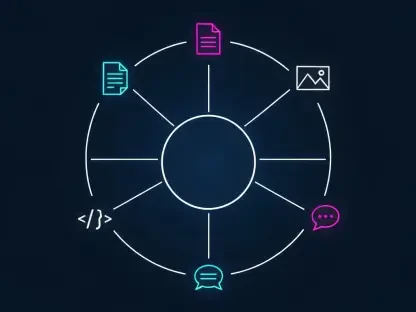As digital transformation accelerates, businesses face an increasingly hostile cybersecurity landscape. The rise in digital touchpoints, remote work, and sophisticated cyber attacks underscores the necessity for robust cybersecurity measures. Yet, many organizations still treat cybersecurity as an afterthought rather than a fundamental aspect of their strategy.
Understanding the Cyber Threat Landscape
The Escalating Cyber Threats
Today’s businesses are encountering a surge in cyber threats. Each new digital integration—be it cloud migration, remote access point, or software adoption—creates potential vulnerabilities that cybercriminals can exploit. As the digital landscape expands, so do the opportunities for malicious actors. The larger and more complex the network, the more potential there is for weak points that can be targeted by sophisticated cyber adversaries. Cybercriminals are continuously evolving their strategies, tapping into more advanced technologies to bypass traditional defenses.
Moreover, businesses are not just facing random attacks but targeted campaigns specifically designed to exploit vulnerabilities in their systems. These attacks can range from data breaches and ransomware to phishing scams and DDoS attacks. Companies must own an understanding of their entire digital footprint to defend themselves effectively. Ensuring that security measures are integrated at every level of digital transformation is imperative. With the stakes so high, sustaining robust cyber defenses is not merely a technical requisite but a critical business priority.
Real-World Consequences
Neglecting cybersecurity can lead to significant consequences. The British Library ransomware attack in 2023, where hackers stole 600GB of data, resulted in damages between £6-7 million. This incident highlights the real impact and financial loss that can be incurred through inadequate cybersecurity measures. Such events serve as harsh reminders that the repercussions of cyber attacks extend far beyond immediate financial losses. Recovery costs, operational disruptions, reputational damage, and potential regulatory penalties all contribute to the overall fallout.
The British Library incident is not isolated. Similar cyber attacks on businesses of all sizes stress the urgency of adopting comprehensive cybersecurity strategies. When companies ignore security basics like robust authentication mechanisms and secure access controls, they are effectively leaving the doors wide open for cybercriminals. The financial and reputational consequences can be devastating, affecting customer trust, market positioning, and ultimately, the bottom line. Hence, investing in cybersecurity is an essential precaution against significant and far-reaching damages.
The Mechanics of Modern Cyber Threats
Rise of AI-Powered Attacks
AI-driven cyber threats are becoming more prevalent, with automated bots scanning for vulnerabilities at an astonishing rate of 2,000 attempts per second. These automated attacks are challenging current defense mechanisms and necessitate a proactive approach to cybersecurity. The rapid pace and volume of such attacks make it impossible for traditional, manual defense systems to keep up. This surge in AI-powered cyber activities calls for equally advanced protective measures.
AI and machine learning technologies, though advantageous for many business processes, are double-edged swords. Cybercriminals harness these tools to automate their attacks, increasing the frequency and reducing the time needed to exploit vulnerabilities. Businesses must therefore deploy AI-driven cybersecurity measures to detect and respond to threats in real time. Strengthening defenses with advanced threat detection systems, behavioral analytics, and continuous monitoring are essential to combating this AI-powered menace. Proactivity and advanced preparation are now the cornerstones of effective cybersecurity.
Growth of Ransomware-as-a-Service (RaaS)
The emergence of Ransomware-as-a-Service has industrialized cybercrime, making sophisticated hacking tools accessible to a wider pool of criminals. This trend significantly lowers barriers to entry and increases attack frequency and sophistication, affecting all sectors, including finance, IT, and defense. No longer confined to elite hackers, ransomware attacks can now be executed by individuals with minimal technical expertise, thanks to the commercialized cybercrime model. The proliferation of RaaS essentially commodifies hacking, making it a more widespread and common threat.
The impact of RaaS on businesses is profound. It has led to an increase in targeted ransomware attacks where cybercriminals demand payments often in cryptocurrency to release stolen or encrypted data. Organizations need to be acutely aware of this growing trend and implement robust countermeasures. Such defenses might include employee training to recognize phishing attempts, regular updates and patches of software, and systematic backups of critical data to mitigate the impact of potential ransomware attacks. Active vigilance and updated defensive strategies are key to countering this expanding threat landscape.
Navigating the Regulatory Landscape
Increasing Regulatory Requirements
Regulatory bodies are responding with stricter cybersecurity mandates. The UK’s proposed Cyber Security and Resilience Bill aims to enforce enhanced security measures and prompt breach reporting. Existing regulations, such as the Data Protection Act 2018 and GDPR, enforce secure handling of personal data, underscoring the legal imperative of robust cybersecurity. As regulations evolve to meet emerging threats, businesses must stay compliant to avoid legal repercussions and sustain customer trust. Adhering to regulatory standards is a critical component of an effective cybersecurity strategy.
These regulations compel organizations to adopt comprehensive security frameworks, ensuring that all personal and sensitive data are protected against unauthorized access. Beyond legal compliance, these measures underpin consumer confidence, crucial for any business’s success. Companies must implement procedures and protocols that fulfill these requirements consistently. Proactive compliance, through regular audits and updates to security policies, helps businesses navigate the complex regulatory landscape while fortifying their overall cybersecurity posture.
Compliance Imperatives
Non-compliance can result in severe penalties and reputational damage. High-profile penalties, like British Airways’ £20 million fine for a 2018 breach, serve as a stark reminder of the legal and financial ramifications of failing to prioritize cybersecurity. Compliance must be viewed through a strategic lens, not just as a mandatory checkbox but as a core component of risk management. Regularly assessing internal controls, conducting thorough risk assessments, and investing in advanced security technologies are crucial steps in maintaining compliance.
Companies should integrate compliance into their broader business strategy. This integration not only protects against potential fines and legal actions but also enhances operational resilience. By embedding cybersecurity within the organizational culture, businesses can align their strategic goals with regulatory necessities, ultimately safeguarding their reputation and financial health. It is imperative to remember that the cost of compliance will always be significantly lower than the cost of a major data breach or regulatory penalty.
From Compliance to Strategy
Integrating Cybersecurity into Business Strategy
It’s essential to move beyond viewing cybersecurity as an isolated IT issue. Embedding cybersecurity into the organizational strategy ensures sustained protection against evolving threats. Proactive measures like regular penetration testing and risk assessments can identify and mitigate vulnerabilities. This strategic integration demands security considerations be woven into every facet of a business’s operational and strategic planning. By treating cybersecurity as a strategic asset, organizations can better prepare for and respond to potential threats.
Moreover, establishing cybersecurity as a foundational element of the business strategy enables more agile and effective responses to threats. Continuous evaluation of security measures through dynamic risk assessments helps identify weak spots preemptively. Regular updates and robust monitoring systems bolster the organization’s defense mechanisms, ensuring preparedness for unforeseen incidents. The goal is to create a robust security culture where cybersecurity is an ongoing priority, not a reactive measure after a breach occurs.
Advanced Defensive Practices
Implementing advanced security measures, such as multi-factor authentication, encryption, and AI-driven threat detection, is critical. As hybrid working models increase reliance on personal devices and unsecured networks, robust endpoint security and ongoing training for employees become vital. Multi-factor authentication ensures that an additional layer of security is in place, making unauthorized access significantly more challenging. Encryption protects data integrity, ensuring that even if data is intercepted, it cannot be easily exploited.
AI-driven threat detection plays a pivotal role in identifying abnormal activities that traditional security measures might overlook. These advanced practices necessitate continuous education and training for employees, turning them into effective frontline defenders against phishing and social engineering attacks. By leveraging these defensive strategies and fostering a security-conscious culture, organizations can significantly enhance their overall cybersecurity resilience. This strategic approach not only protects against current threats but also future-proofs the organization against evolving cyber risks.
Enhancing Cybersecurity Preparedness
Training and Incident Response
Employees often represent the weakest link in cybersecurity. Continuous training on phishing and social engineering defenses is necessary to fortify this frontline. An effective incident response plan, regularly rehearsed, can minimize damage during a cyber incident. Awareness training must cover the latest threat vectors and attack methods, equipping employees to recognize and report suspicious activities effectively. Regular drills and simulations ensure that responses are swift and coordinated.
The importance of an incident response plan cannot be overstated. Such a plan outlines the immediate steps to contain and mitigate the impact of a cyber attack, ensuring business continuity. Well-defined roles and responsibilities, coupled with regular updates and rehearsals, enable businesses to respond promptly and efficiently. By preparing for the worst, organizations can reduce downtime, financial losses, and reputational harm, ensuring a swift recovery and return to normal operations.
Third-Party Risk Management
As the pace of digital transformation quickens, companies encounter an increasingly menacing cybersecurity environment. The surge in digital interactions, the shift to remote work, and the evolution of sophisticated cyber threats all highlight the crucial need for strong cybersecurity protocols. Despite this, many businesses continue to regard cybersecurity as an optional extra rather than an integral part of their overall strategy.
The modern business landscape demands that organizations acknowledge the importance of cybersecurity not just as a protective measure, but as a vital component embedded in their operational blueprint. In order to safeguard sensitive data, maintain customer trust, and ensure uninterrupted business operations, it is essential to implement comprehensive cybersecurity measures. Companies that prioritize cybersecurity can better defend against breaches and minimize potential damages. Fostering a culture of security awareness and incorporating advanced technologies helps create a more resilient defense against the ever-evolving threats that jeopardize today’s digital operations.









